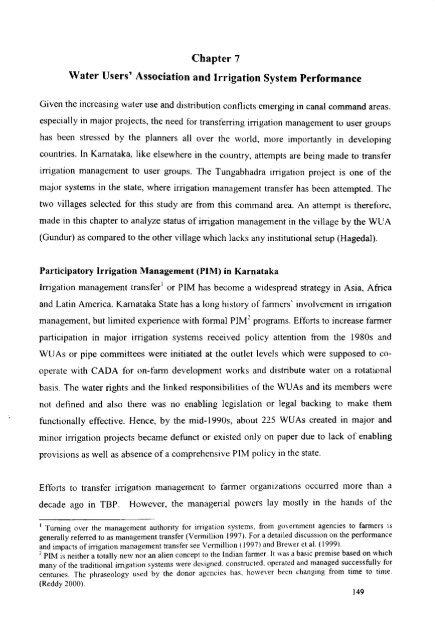Water Users Association and Irrigation Management - Institute for ...
Water Users Association and Irrigation Management - Institute for ...
Water Users Association and Irrigation Management - Institute for ...
Create successful ePaper yourself
Turn your PDF publications into a flip-book with our unique Google optimized e-Paper software.
Chapter 7<br />
<strong>Water</strong> <strong>Users</strong>' <strong>Association</strong> <strong>and</strong> <strong>Irrigation</strong> System Per<strong>for</strong>mance<br />
Given the increasing water use <strong>and</strong> distribution contlicts emerging in canal comm<strong>and</strong> areas,<br />
especially in major projects, the need <strong>for</strong> transferring irrigation management tu user gruups<br />
has been stressed by the planners all over the world, more importantly in developing<br />
countries. In Karnataka, like elsewhere in the country, attempts are being made to transfer<br />
irrigation management to user groups. The Tungabhadra irrigation project is one of the<br />
major systems in the state, where irrigatiun management transfer has been attempted. The<br />
two villages selected <strong>for</strong> this study are from this comm<strong>and</strong> area. An attempt is there<strong>for</strong>e,<br />
made in this chapter to analyze status of irrigation management in the village by the WUA<br />
(Gundur) as compared to the other village which lacks any institutional setup (Hagedal).<br />
Participatory <strong>Irrigation</strong> <strong>Management</strong> (PIM) in Karnataka<br />
<strong>Irrigation</strong> management transfer I or PIM has become a widespread strategy in Asia, Africa<br />
<strong>and</strong> Latin America. Karnataka State has a long history uffarmers' involvement in irrigation<br />
management, but limited experience with <strong>for</strong>mal PIM 2 programs. Ef<strong>for</strong>ts to increase farmer<br />
participation in major irrigation systems received policy attention from the 1980s <strong>and</strong><br />
WUAs or pipe committees were initiated at the outlet levels which were supposed to cooperate<br />
with CADA <strong>for</strong> on-farm development works <strong>and</strong> distribute water on a rotatiDnal<br />
basis. The water rights <strong>and</strong> the linked responsibilities of the WUAs <strong>and</strong> its members were<br />
not defined <strong>and</strong> also there was no enabling legislation or legal backing to make them<br />
functionally effective. Hence, by the mid-1990s, about 225 WUAs created in major <strong>and</strong><br />
minor irrigation projects became defunct or existed only on paper due to lack of enabling<br />
provisions as well as absence of a comprehensive PIM policy in the state.<br />
Et10rts to transfer irrigation management to farmer organizations occurred more than a<br />
decade ago in TBP.<br />
However, the managerial powers lay mostly in the h<strong>and</strong>s of the<br />
I Turning over the management authority <strong>for</strong> irrigation systems. from government agencies to farmers is<br />
generally referred to as management transfer (Vermillion 1997). For a detailed discussion on the per<strong>for</strong>mance<br />
<strong>and</strong> impacts of irrigation management transfer see Vermillion (1997) <strong>and</strong> Brewer eta!' (1999). .<br />
2 PIM is neither a totally new nor an alien concept to the Indian farmer. It was a basIC premise based on which<br />
many of the traditional irrigation systems were designed. constructed. operated <strong>and</strong> managed successfully <strong>for</strong><br />
centuries. The phraseology used by the donor agencies has, however been changmg from time to time.<br />
(Reddy 2000).<br />
149
















